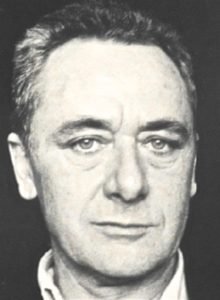 Gerhard Richter, born 1932 in Dresden, is a German visual artist. Richter has produced abstract as well as photorealistic paintings, and also photographs and installations. He studied painting at the Kunstakademie in Dresden from 1952 to 1956 and thereafter he became a very successful Social Realist painter. In 1961 he entered West Germany, and from that year to 1963 he attended the Kunstakademie in Düsseldorf. He met Sigmar Polke, Konrad Lueg (later Konrad Fischer), and Blinky Palermo. Richter preferred an objective approach, using a projector at first, began to make photo-based paintings relying on scenes from newspapers, personal photographs and magazines. Richter painted the victims of serial killers, portraits of famous European intellectuals and German Red Army Fraction and other media images. His later work includes landscapes, city scenes, and portraits of his family, friends, and art world associates, all rendered in a soft-focus realism. At the same time, he developed a large body of gestural abstractions of every scale, using an array of painting methods. Particularly he use a handmade squeegee technique that pushes and scrapes layers of coloured paint across the field of the canvas. He also created series of colour-chart paintings, which were the inspiration for his 2007 large stained glass window for south wing of Cologne Cathedral. Richter received many awards, among them the Golden Lion at the 47th Venice Biennale (1997) and the Japan Art Association’s Praemium Imperiale prize (1997). Since then he became one of the most expensive artists during lifetime. He works and lives in Cologne.
Gerhard Richter, born 1932 in Dresden, is a German visual artist. Richter has produced abstract as well as photorealistic paintings, and also photographs and installations. He studied painting at the Kunstakademie in Dresden from 1952 to 1956 and thereafter he became a very successful Social Realist painter. In 1961 he entered West Germany, and from that year to 1963 he attended the Kunstakademie in Düsseldorf. He met Sigmar Polke, Konrad Lueg (later Konrad Fischer), and Blinky Palermo. Richter preferred an objective approach, using a projector at first, began to make photo-based paintings relying on scenes from newspapers, personal photographs and magazines. Richter painted the victims of serial killers, portraits of famous European intellectuals and German Red Army Fraction and other media images. His later work includes landscapes, city scenes, and portraits of his family, friends, and art world associates, all rendered in a soft-focus realism. At the same time, he developed a large body of gestural abstractions of every scale, using an array of painting methods. Particularly he use a handmade squeegee technique that pushes and scrapes layers of coloured paint across the field of the canvas. He also created series of colour-chart paintings, which were the inspiration for his 2007 large stained glass window for south wing of Cologne Cathedral. Richter received many awards, among them the Golden Lion at the 47th Venice Biennale (1997) and the Japan Art Association’s Praemium Imperiale prize (1997). Since then he became one of the most expensive artists during lifetime. He works and lives in Cologne.
LINKS
